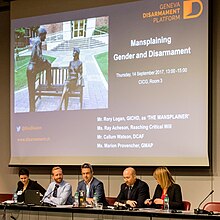
Back عجرفة ذكورية Arabic Mansplaining Catalan Mansplaining Danish Mansplaining German Mansplaining Greek Mansplaining Spanish Arzalpen Basque مردفهمکردن Persian Mansplaining Finnish Mansplaining French

Mansplaining (a blend word of man and the informal form splaining of the gerund explaining) is a pejorative term meaning "(for a man) to comment on or explain something, to a woman, in a condescending, overconfident, and often inaccurate or oversimplified manner".[3][4][5][6]
In its original use, mansplaining differed from other forms of condescension in that it was said to be rooted in the assumption that a man is likely to be more knowledgeable than a woman.[7] However, it has come to be used more broadly, often applied when a man takes a condescending tone in an explanation to anyone, regardless of the age or gender of the intended recipients: a "man 'splaining" can be delivered to any audience.[4]
In 2013 Dictionary.com said it was adding both mansplain and the suffix (libfix) -splain to its dictionary.[8] Its announcement read in part: "In addition to being creative, this term, particularly the -splaining part, has proven to be incredibly robust and useful as a combining form in 2013." Mansplaining has also engendered parallel constructions such as womansplaining, whitesplaining, rightsplaining,[9] and goysplaining.[10]
As the word became more popular, several commentators complained that misappropriation had diluted its original meaning.[11] Joshua Sealy-Harrington and Tom McLaughlin wrote in newspaper The Globe and Mail that the term has been used as an ad hominem to silence debate.[12]
- ^ Anon (2018). "Classmates, San Antonio, Texas by Paul Tadlock". atlasobscura.com. Atlas Obscura. Retrieved 27 June 2021.
What was meant as an innocent piece of art has earned a reputation as the 'mansplaining sculpture.'
- ^ Salazar, Albert (28 May 2015). "UIW Statue Gets National Attention Thanks To Feminism And Twitter". San Antonio Current. Archived from the original on 27 July 2021. Retrieved 27 June 2021.
The bronze statue is called 'Classmates,' and was sculpted by SA artist Paul Tadlock, according to the Times. But it's now known as 'Mansplaining The Statue,' thanks to people on the internet […].
- ^ "mansplain". Dictionary.com.
[T]o explain something to a woman in a condescending, overconfident, and often inaccurate or oversimplified manner, typically to a woman already knowledgeable about the topic[.]
- ^ a b "History of Mansplaining". Merriam-Webster.com.
It's what occurs when a man talks condescendingly to someone (especially a woman) about something he has incomplete knowledge of, with the mistaken assumption that he knows more about it than the person he's talking to does.
- ^ Steinmetz, Katy (18 November 2014). "Clickbait, Normcore, Mansplain: Runners-Up for Oxford's Word of the Year". Time. Retrieved 24 November 2014.
[T]o explain something to someone, typically a man to woman, in a manner regarded as condescending or patronizing.
- ^ Zimmer, Ben (5 January 2013). "Tag, You're It! "Hashtag" Wins as 2012 Word of the Year". Visual Thesaurus. Retrieved 30 October 2014.
[W]hat happens when a man condescendingly explains something to female listeners[.]
- ^ Jaschik, Scott (16 October 2012). "Calling Out Academic 'Mansplaining'". Inside Higher Ed.
[S]ome men explain things to women with condescension, frequently ignoring the reality that the women may already understand whatever is being explained (in many cases, better than do the men).
- ^ Solomon, Jane (6 December 2013). "Word Watch 2013: -splain". Dictionary.com. Retrieved 24 November 2014.
The possibilities are seeming endless on the -splain front. This gives Dictionary.com reason to believe that -splain is not just a temporary fad, but rather a stable new addition to English along with its libfix cousins like -gate, -pocalypse, and -zilla.
- ^ Zimmer, Benjamin; Carson, Charles C. (2013). "Among The New Words". American Speech. 88 (2): 196–214. doi:10.1215/00031283-2346771.(subscription required)
- ^ Marcus, Marcus (30 March 2015). "The Art of Goysplaining". The Forward.
Goysplaining is an outgrowth of people thinking that they know a lot about Judaism. […] The people who goysplain think that because they went to the trouble of reading an article, watching a documentary, or Googling something, they now understand an entire faith and should be congratulated for it.
- ^ Hart, Benjamin (20 October 2014). "RIP "mansplaining": How the Internet killed one of our most useful words". Salon. Retrieved 30 October 2014.
But along the way, mansplaining has morphed from a useful descriptor of a real problem in contemporary gender dynamics to an increasingly vague catchall expression that seems to be inflaming the Internet gender wars more than clarifying them.
- ^ McLaughlin, Tom; Sealy-Harrington, Joshua (15 April 2014). "Arguments should not be silenced because of their author's race or sex". The Globe and Mail.
The use of terms such as 'mansplaining' (and its racial counterpart, 'whitesplaining') can cause disengagement. […] Without such engagement, these terms become unconstructive ad hominem attacks that sidestep meaningful debate when an opponent conveniently possesses privilege.